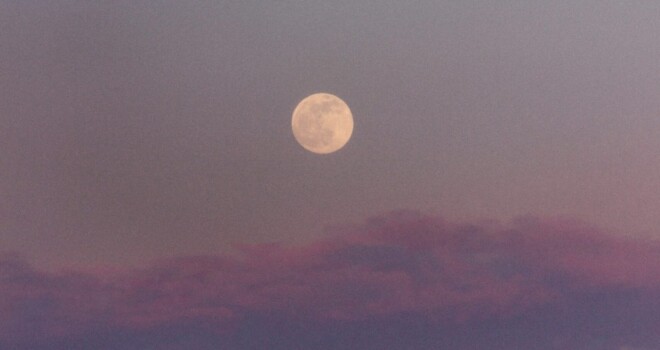“Let there be light” is such a powerful and memorable phrase that it dwarfs what Genesis 1:16 states shortly thereafter concerning the creation of the moon. It is appropriate, then, that Monday should follow Sunday. The moon follows the sun as the night follows the day: “And God made the two great lights—the greater light to rule the day and the lesser light to rule the night . . .” Psalm 104:19 informs us that “He made the moon to mark the seasons.” The moon was formed, according to scientists, 4.51 billion years ago after the earth’s formation. It has been orbiting ever since, a tribute to the constancy of the cosmos.
We cannot look directly at the sun without being blinded; but the soft glow of the moon is relaxing. Ancient watchers of the sky were fascinated by the moon’s cycles and how it changed position and shape before it disappeared from the sky only to return again. It repeated this cycle over a period of 29 days. This allowed people to count the days and predict the arrival of the seasons. Its period, being roughly a month, is the basis for its name, since the word “month” is derived from the word “moon.”
The waxing and waning of the moon symbolizes the fickle nature of man, his changing heart, and lack of constancy. The sun, by contrast, is immobile. The sun is 92 million miles from the earth, while the moon is its neighbor, a mere 250,000 miles away—close enough to occupy. The sun and moon attest to the diversity of God’s creation.
The fact that the lunar cycle is nearly a month corresponds to a woman’s menstrual cycle. It was once believed that if a woman merely looked at a full moon she became pregnant. On the other hand, a person adversely affected by the moon could become a luna-tic. Werewolves, according to folklore, came out during a full moon. The moon influenced men, women, and the tides in different ways.
The moon is the middle ground between the light of the sun and the darkness of the night. Hence, some people believed that it represents the realm between the conscious and the unconscious. It affects the earth in many ways, not only the tides, but the rains, the waters, and the seasons. And its gravity keeps the earth rotating on its proper tilt.
A professor of engineering, a victim of the technological imperative, once said that since we now have the technology, we should blow up the moon. The destruction of the moon would be catastrophic. The moon is far more than a pleasant object in the sky at night. It is a ruler. Getting rid of the moon would be akin to assassinating a king.
The moon shows the earth the same face. How the moon appears on its other face remains a mystery. Nonetheless the pock-marked face that seemingly looks at us smiles on lovers. Hence, the endless number of songs that include the moon in its title: Moon River, Fly Me to the Moon, Moonlight and Roses, Moonlight Becomes You, Moon over Miami, Blue Moon, Moon Dreams, Moonglow, Racing with the Moon, Lazy Moon and Moonglow. And we should not forget, Glenn Miller’s Moonlight Serenade (he also composed Moonlight Cocktail) or Beethoven’s Moonlight Sonata. A theme from Rachmaninoff’s Second Piano Concerto became the popular tune, Full Moon and Empty Arms. A full moon plays Cupid from a distance. It warms the heart. People become amorous when they are “moonstruck,” the title of a movie that features the most outrageous musical introduction sung by Dean Martin: “When the moon hits your eye like a big pizza pie, that’s amore.” On a loftier level of poetry, Edgar Allan Poe wrote, “For the moon never beams without sending me dreams.”
Moonshine is made at night under the light of the moon. But, also, people love to spoon under the light of the silvery moon. Moonlight is far more romantic than sunlight. It lifts the lid of both prohibition and inhibition. Poetess Maggie Dewane said, “Let’s dance together on moonbeams. On this cool spring eve. The nights are young. And ready for teasing. There’s mischief in the night air.”
A “blue moon” is the second full moon that appears within the same calendar month. This occurs every thirty-two months, virtually a month of months—hence, the phrase “once in a blue moon,” referring to something that happens rarely.
For Christianity, the moon is a symbol of faith. This is because we need a light in our darkest moments. The moon lightens our path when our vision is limited. It saves the night from complete invisibility. There are times when we see so little that faith is the only thing that guides us.
The moon is a well-known symbol of Mary, the Mother of God. Just as the moon reflects the light of the sun, so the splendor of the immaculate Virgin Mary reflects the light of the true Sun, God.
What is the moon saying to us? Have faith! Know that faith has its own light. And though it may seem dim, it can offer us a better way of navigating through life than what we can see in the light of day. The moon, as does the sun, proclaims the glory of God.
We might imagine the moon in terms of the three supernatural virtues: faith, hope, and love. Moonglow lights our path and represents the faith we live by. Moonshine is what we see when we look at the face of the moon reflecting the sun, stirring our hope to be with God. Moonbeams are the currents of love that the moon sends our way.
Photo by Altınay Dinç on Unsplash















